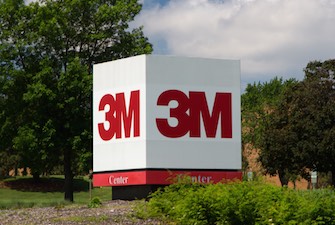 The 3M Company (NYSE:MMM) based in Maplewood, MN, is an American conglomerate that markets a wide range of materials, including laminates, abrasives, electronic materials, optical films and more. The company also has a medical products business that recently reached an agreement with the research & development wing of British-Swedish pharmaceutical company AstraZeneca (NYSE:AZN) to develop a cancer immunotherapy drug using MEDI9197, a medical molecule created by 3M Drug Delivery Systems. Near the middle of September, 3M announced that it was perhaps seeking to sell its health information services business, a unit that has earned more than $700 million in annual sales by providing software and other services to doctors, insurance providers, hospitals and government agencies. By the end of September, the company was preparing to break ground on a $40 million construction project to build a nearly one million square-foot facility at a site in DeKalb, IL.
The 3M Company (NYSE:MMM) based in Maplewood, MN, is an American conglomerate that markets a wide range of materials, including laminates, abrasives, electronic materials, optical films and more. The company also has a medical products business that recently reached an agreement with the research & development wing of British-Swedish pharmaceutical company AstraZeneca (NYSE:AZN) to develop a cancer immunotherapy drug using MEDI9197, a medical molecule created by 3M Drug Delivery Systems. Near the middle of September, 3M announced that it was perhaps seeking to sell its health information services business, a unit that has earned more than $700 million in annual sales by providing software and other services to doctors, insurance providers, hospitals and government agencies. By the end of September, the company was preparing to break ground on a $40 million construction project to build a nearly one million square-foot facility at a site in DeKalb, IL.
Many of the innovations coming out of 3M’s laboratories are developed for various kinds of heavy industrial work. The company recently unveiled a new glass bubble product to serve as a density reducing agent in cement slurries used in oil and gas well production. 3M’s organic vapor respirator cartridges, used in industrial respirator equipment to protect workers from harmful organic 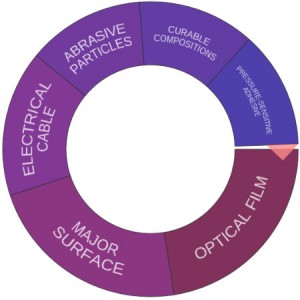 vapors, have recently been outfitted with end-of-service-life indicators to ensure that cartridges are replaced at the proper time. Workplace safety and health standards compliance is also made easier by 3M’s Active Safety, a new communications system using radio-frequency identification (RFID) tags installed on personal protective equipment (PPE) to gather usage data and document safety programs more efficiently.
vapors, have recently been outfitted with end-of-service-life indicators to ensure that cartridges are replaced at the proper time. Workplace safety and health standards compliance is also made easier by 3M’s Active Safety, a new communications system using radio-frequency identification (RFID) tags installed on personal protective equipment (PPE) to gather usage data and document safety programs more efficiently.
During 2014, 3M received 517 patents from the U.S. Patent and Trademark Office, putting it in 80th place among companies petitioning the USPTO for patents that year, and 3M patents total 143 U.S. patents in the past three months, according to Innography’s patent portfolio analysis tools. The text cluster provided here details widespread R&D in optical film, electrical cable, abrasive particles and curable compositions.
[Companies-1]
3M’s Issued Patents: From Inflatable Pads for Surgery to Glass Bubbles in Wall Repair Compound
 Given the recent activities in 3M’s medical business, we were careful to note any medical technologies developed by the company and found a couple to share with readers. U.S. Patent No. 9072598, issued under the title Inflatable Convective Pad for Surgery, protects an inflatable pad for warming a person which includes first and second layers, one of which is air-permeable, joined by a seal around a common periphery to form a pneumatic structure, an inlet port opening into the pneumatic structure, an inactive area near the inflatable convective pad’s head end and spaced-apart seals between the first and second layer each having slit means for threading a limb or limb retainer through the inflatable pad. This innovation is intended to provide the clinical benefits of warming a person during surgery, which encourages wound healing and immune system function, while addressing the shortcomings of conventional patient warming methods which can interfere with surgical procedures. Inexpensive and high-quality dental restorations are at the center of U.S. Patent No. 9138302, which are titled Method and Device for Making a Dental Workpiece. It claims a method of making a dental workpiece by suspending machining of the workpiece, exposing the workpiece to a first air jet providing air at a first velocity, exposing the workpiece to a second air jet providing air at a lower velocity and causing relative movement between the two air jets and the workpiece according to predetermined coordinates. This invention achieves efficient cleaning of a dental workpiece to facilitate faster and cheaper production. Nanomaterials for use in improving x-ray imaging in dental and medical applications is detailed within U.S. Patent No. 9139670, which is titled Surface-Modified Zirconia Nanoparticles. This patent protects surface-modified nanoparticles including zirconia nanoparticles and a ligand attached to at least one nanoparticle and containing a hydroxamate functionality and reactive group containing a chain transfer group or photoinitiator group. These nanoparticles are an improvement over conventional zirconia products which are thermodynamically unfavorable and difficult to prepare.
Given the recent activities in 3M’s medical business, we were careful to note any medical technologies developed by the company and found a couple to share with readers. U.S. Patent No. 9072598, issued under the title Inflatable Convective Pad for Surgery, protects an inflatable pad for warming a person which includes first and second layers, one of which is air-permeable, joined by a seal around a common periphery to form a pneumatic structure, an inlet port opening into the pneumatic structure, an inactive area near the inflatable convective pad’s head end and spaced-apart seals between the first and second layer each having slit means for threading a limb or limb retainer through the inflatable pad. This innovation is intended to provide the clinical benefits of warming a person during surgery, which encourages wound healing and immune system function, while addressing the shortcomings of conventional patient warming methods which can interfere with surgical procedures. Inexpensive and high-quality dental restorations are at the center of U.S. Patent No. 9138302, which are titled Method and Device for Making a Dental Workpiece. It claims a method of making a dental workpiece by suspending machining of the workpiece, exposing the workpiece to a first air jet providing air at a first velocity, exposing the workpiece to a second air jet providing air at a lower velocity and causing relative movement between the two air jets and the workpiece according to predetermined coordinates. This invention achieves efficient cleaning of a dental workpiece to facilitate faster and cheaper production. Nanomaterials for use in improving x-ray imaging in dental and medical applications is detailed within U.S. Patent No. 9139670, which is titled Surface-Modified Zirconia Nanoparticles. This patent protects surface-modified nanoparticles including zirconia nanoparticles and a ligand attached to at least one nanoparticle and containing a hydroxamate functionality and reactive group containing a chain transfer group or photoinitiator group. These nanoparticles are an improvement over conventional zirconia products which are thermodynamically unfavorable and difficult to prepare.
 An innovative eyewear component that improves the fit of eyewear for a wide range of people is featured within U.S. Patent No. 9116364, entitled Eyewear Having a Flexural Member. The eyewear article disclosed here has a temple piece extending rearwardly from an eyewear article’s front and having a flexing portion comprising multiple longitudinally disposed ribs; the flexing portion also exhibits an area moment of inertia at a cross-sectional location. This allows eyewear to be worn more comfortably regardless of a user’s head size.
An innovative eyewear component that improves the fit of eyewear for a wide range of people is featured within U.S. Patent No. 9116364, entitled Eyewear Having a Flexural Member. The eyewear article disclosed here has a temple piece extending rearwardly from an eyewear article’s front and having a flexing portion comprising multiple longitudinally disposed ribs; the flexing portion also exhibits an area moment of inertia at a cross-sectional location. This allows eyewear to be worn more comfortably regardless of a user’s head size.
3M is also in the business of marketing new types of compounds used for building construction projects, as readers can see within U.S. Patent No. 9115267, which is titled Lightweight Wall Repair Compounds. The wall repair compound protected here contains an aqueous latex binder emulsion in an amount ranging from 20 percent to 80 percent by weight of the compound, as well as an inorganic filler system containing glass bubbles in an amount ranging from 20 percent to 70 percent by weight of the compound. The resulting wall repair compound is low density and can be applied and painted over once dry without requiring the use of primer.
We also wanted to take some time to explore the intriguing material innovation discussed within U.S. Patent No. 9116285, which is titled Light Directing Film. It protects a light directing film with a first structured major surface having a plurality of unitary discrete structures with a plurality of side facets arranged at a certain angle to the film, a light directing portion and a bonding portion, as well as an opposing second major surface. The resulting film product is capable of directing light and can be securely attached to neighboring surfaces with very little loss in optical properties.
[Companies-2]
Patent Applications of Note: From Glass Roofing Materials to Digital Post-It Notes
Surveying 3M’s recently filed patent applications we noted further development in glass bubble technologies reflected within U.S. Patent Application No. 20150218349, titled Glass Bubbles, Composites Therefrom, and Method of Making Glass Bubbles. It would protect a method of making a graded fraction of glass bubbles by providing a plurality of glass bubbles of a particular median size, removing a portion of the glass bubbles at least 40 micrometers in size, removing a portion of the glass bubbles up to 10 micrometers in size and producing a resulting plurality of glass bubbles which is both less dense and at least as strong as the original plurality of glass bubbles. This innovation results in the production of glass bubbles which are less prone to breaking when used for high-pressure spraying, sintering or thermoforming. The use of specially formed glass materials for constructing energy-efficient buildings is 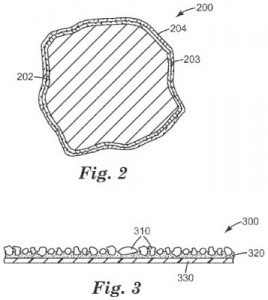 discussed within U.S. Patent Application No. 20150225957, filed under the title Porous Glass Roofing Granules. The roofing granule claimed here is comprised of a glass substrate and a plurality of pores within the substrate; the roofing granule achieves a minimum total solar reflectance of at least 50 percent. This roofing technology is able to prevent the absorption of solar energy into a building, reducing the ambient temperature of rooms within the building. Glass beads are also part of the novel liquid composition developed for marking roadways that would be protected by U.S. Patent Application No. 20150252195, which is titled Pavement Marking Compositions. It discloses a composition comprised of a blend including a binder comprised of either a C5 hydrocarbon resin or a resin containing rosin; the blend also includes a polydimethylsiloxane polyamide copolymer. The inclusion of optical elements like glass beads increases the retroreflectivity of pavement markings, making them more visible at night.
discussed within U.S. Patent Application No. 20150225957, filed under the title Porous Glass Roofing Granules. The roofing granule claimed here is comprised of a glass substrate and a plurality of pores within the substrate; the roofing granule achieves a minimum total solar reflectance of at least 50 percent. This roofing technology is able to prevent the absorption of solar energy into a building, reducing the ambient temperature of rooms within the building. Glass beads are also part of the novel liquid composition developed for marking roadways that would be protected by U.S. Patent Application No. 20150252195, which is titled Pavement Marking Compositions. It discloses a composition comprised of a blend including a binder comprised of either a C5 hydrocarbon resin or a resin containing rosin; the blend also includes a polydimethylsiloxane polyamide copolymer. The inclusion of optical elements like glass beads increases the retroreflectivity of pavement markings, making them more visible at night.
3M has been coming up with some interesting digital technologies for its Post-It adhesive notepads as readers can see within U.S. Patent Application No. 20150262023, entitled 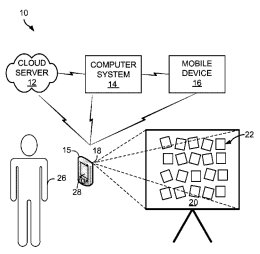 Systems and Methods for Note Recognition. This would protect a method of collecting content of notes by capturing a visual representation of a scene having multiple physical notes with predefined boundaries and recognizable content thereon, processing image data associated with the scene’s visual representation to identify a mark of a first physical note, identifying a predefined boundary of the first physical mark, extracting recognizable content within the first note’s predefined boundary and associating the recognizable content with a digital note representative of the physical note. The technology automatically generates digital notes from physical notes posted in a workspace in order to make work collaboration more efficient and easier to manage.
Systems and Methods for Note Recognition. This would protect a method of collecting content of notes by capturing a visual representation of a scene having multiple physical notes with predefined boundaries and recognizable content thereon, processing image data associated with the scene’s visual representation to identify a mark of a first physical note, identifying a predefined boundary of the first physical mark, extracting recognizable content within the first note’s predefined boundary and associating the recognizable content with a digital note representative of the physical note. The technology automatically generates digital notes from physical notes posted in a workspace in order to make work collaboration more efficient and easier to manage.
Electrical cables for the processing of data at high speeds are the focal point of U.S. Patent Application No. 20150255191, entitled Shielded Electrical Ribbon Cable with Dielectric Spacing. The electrical ribbon cable claimed here includes a conductor set comprised of two elongated conductors extending from end to end on the cable, two flexible shielding films extending from end to end on the cable and disposed on opposite sides of the cable, and then a second dielectric disposed between the shielding films and extending between closest points of proximity of the first dielectrics of the conductor set. This invention intends to provide an electrical ribbon cable which is optimized for mass-termination for simultaneous connection of conductors to individual contact elements, which can improve high speed data transmission but reduce flexibility.
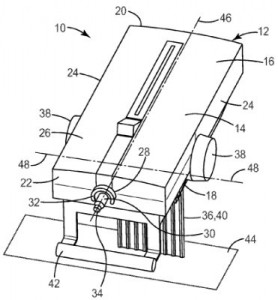 More dental material innovations are being pursued by 3M which is clear by the filing of U.S. Patent Application No. 20150216634, which is titled Device for Dispensing a Dental Material. The device for dispensing a dental material disclosed here includes a body having a compartment for receiving the dental material, a piston for extruding the dental material from the compartment, a drive for moving the piston relative to the compartment and a handle operable to pivot the body and carrying the device. This dispensing device is designed to be more portable and more easily stored than conventional devices used for extruding dental materials.
More dental material innovations are being pursued by 3M which is clear by the filing of U.S. Patent Application No. 20150216634, which is titled Device for Dispensing a Dental Material. The device for dispensing a dental material disclosed here includes a body having a compartment for receiving the dental material, a piston for extruding the dental material from the compartment, a drive for moving the piston relative to the compartment and a handle operable to pivot the body and carrying the device. This dispensing device is designed to be more portable and more easily stored than conventional devices used for extruding dental materials.
Finally, we thought we’d share a materials innovation meant for the improved production of web-like materials used in a variety of applications detailed within U.S. Patent Application No. 20150217960, filed under the title Adaptable Web Spreading Device. The spreader roll that would be protected here includes a reverse crown roll having a major surface, two ends and a variable diameter that decreases from an end to a midpoint, and then an engagement cover with a resilient engagement surface disposed over the major surface of the reverse crown roll. This spreader roll is designed to better handle the high-speed, high-capacity manufacture of specialty plastics and optical films which have very rigorous and strict specifications.

![[IPWatchdog Logo]](https://ipwatchdog.com/wp-content/themes/IPWatchdog%20-%202023/assets/images/temp/logo-small@2x.png)


![[Advertisement]](https://ipwatchdog.com/wp-content/uploads/2024/04/UnitedLex-May-2-2024-sidebar-700x500-1.jpg)
![[Advertisement]](https://ipwatchdog.com/wp-content/uploads/2024/04/Artificial-Intelligence-2024-REPLAY-sidebar-700x500-corrected.jpg)
![[Advertisement]](https://ipwatchdog.com/wp-content/uploads/2024/04/Patent-Litigation-Masters-2024-sidebar-700x500-1.jpg)

![[Advertisement]](https://ipwatchdog.com/wp-content/uploads/2021/12/WEBINAR-336-x-280-px.png)
![[Advertisement]](https://ipwatchdog.com/wp-content/uploads/2021/12/2021-Patent-Practice-on-Demand-recorded-Feb-2021-336-x-280.jpg)
![[Advertisement]](https://ipwatchdog.com/wp-content/uploads/2021/12/Ad-4-The-Invent-Patent-System™.png)






Join the Discussion
No comments yet.